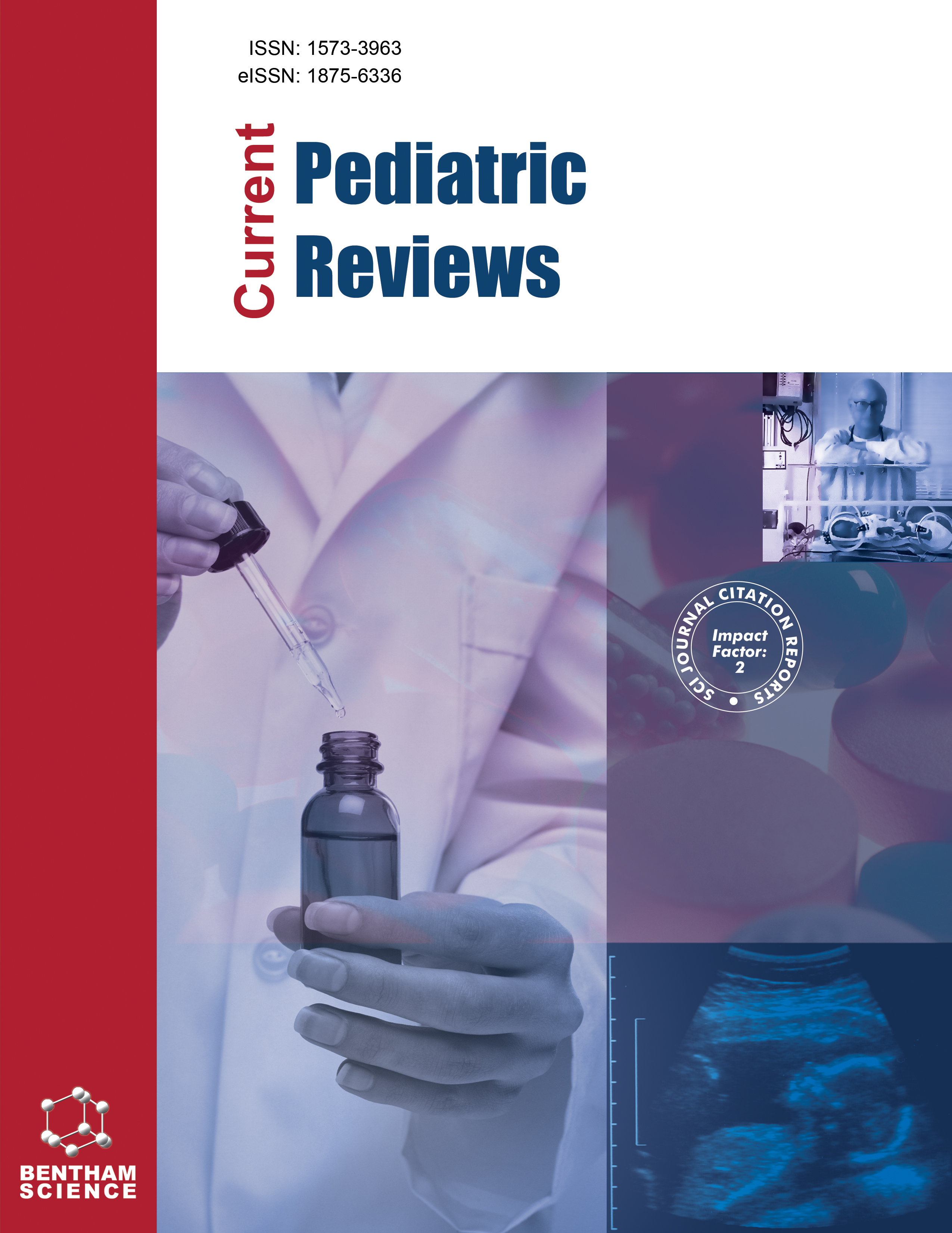- Home
- A-Z Publications
- Current Pediatric Reviews
- Previous Issues
- Volume 10, Issue 1, 2014
Current Pediatric Reviews - Volume 10, Issue 1, 2014
Volume 10, Issue 1, 2014
-
-
Conventional (Continuous) EEG Monitoring in the NICU
More LessAuthors: Taeun Chang and Tammy N. TsuchidaConventional EEG is being used more frequently in NICUs in the U.S. with the advent of therapeutic hypothermia and the growth of neurocritical care intensivists & units. Historical applications have included assessing encephalopathy, seizure evaluation and prognosis. Past reluctance or limitation of the use in the NICU are receding with the digitization of EEG recordings and increasing interest in the neonatal brain. Contin Read More
-
-
-
Amplitude-Integrated EEG and the Newborn Infant
More LessAuthors: Divyen K. Shah and Amit MathurThere is emerging recognition of the need for continuous long term electrographic monitoring of the encephalopathic neonate. While full-montage EEG with video remains the gold standard for monitoring, it is limited in application due to the complexity of lead application and specialized interpretation of results. Amplitude integrated EEG (aEEG) is derived from limited channels (usually C3-P3, C4-P4) and is filtered, rectifie Read More
-
-
-
Cranial Ultrasound - Optimizing Utility in the NICU
More LessAuthors: Gerda van Wezel-Meijler and Linda S de VriesCranial ultrasonography (cUS) is a reliable tool to detect the most frequently occurring congenital and acquired brain abnormalities in full-term and preterm neonates. Appropriate equipment, including a dedicated ultrasound machine and appropriately sized transducers with special settings for cUS of the newborn brain, and ample experience of the ultrasonographist are required to obtain optimal image quality. When, in additio Read More
-
-
-
Magnetic Resonance Imaging in the Encephalopathic Term Newborn
More LessNeonatal encephalopathy is a neurological emergency with heterogeneous etiologies and several management challenges. Neonatal encephalopathy of hypoxic-ischemic origin is associated with high rate of neonatal morbidity and mortality, and the long-term neurodevelopmental outcome of survivors with moderate to severe encephalopathy is poor. Magnetic resonance imaging now provides new insights on the di Read More
-
-
-
Magnetic Resonance Spectroscopy Biomarkers in Term Perinatal Asphyxial Encephalopathy: From Neuropathological Correlates to Future Clinical Applications
More LessAuthors: Nicola J. Robertson, Sudhin Thayyil, Ernest B. Cady and Gennadij RaivichNeonatal brain injury remains a devastating condition, with poor outcomes despite the institution of an effective neuroprotective strategy of therapeutic hypothermia. There is an urgent need to develop additional neuroprotective strategies and to tailor our clinical predictive ability for families and their infants. Such goals could be more readily achieved if reliable early clinical indicators or biomarkers existed. This revie Read More
-
-
-
Magnetic Resonance Imaging of the Preterm Infant Brain
More LessAuthors: Valentina Doria, Tomoki Arichi and A. David EdwardsDespite improvements in neonatal care, survivors of preterm birth are still at a significantly increased risk of developing life-long neurological difficulties including cerebral palsy and cognitive difficulties. Cranial ultrasound is routinely used in neonatal practice, but has a low sensitivity for identifying later neurodevelopmental difficulties. Magnetic Resonance Imaging (MRI) can be used to identify intracranial abnormalities wi Read More
-
-
-
Advanced Magnetic Resonance Imaging Techniques in the Preterm Brain: Methods and Applications
More LessAuthors: Joshua D. Tao and Jeffrey J. NeilBrain development and brain injury in preterm infants are areas of active research. Magnetic resonance imaging (MRI), a non-invasive tool applicable to both animal models and human infants, provides a wealth of information on this process by bridging the gap between histology (available from animal studies) and developmental outcome (available from clinical studies). Moreover, MRI also offers information rega Read More
-
-
-
Neurobehavioral Evaluation in the Preterm and Term Infant
More LessAuthors: Nisha Brown and Alicia SpittleNeurobehavioral examinations of babies, both term and preterm, have been used in neonatology for many decades. However, with the advent of new technologies and, perhaps more “scientific” ways of assessing high risk infants, it seems that neurobehavioral examinations may have become somewhat redundant in some nurseries. Yet these examinations remain an important part of clinical practice. They help to increase our Read More
-
-
-
Near Infrared Optical Technologies to Illuminate the Status of the Neonatal Brain
More LessAuthors: Steve M. Liao and Joseph P. CulverThe neurodevelopmental outcome of at-risk infants in the neonatal intensive care unit (NICU) is concerning despite steady improvement in the survival rate of these infants. Our current management is often complicated by delayed realization of cerebral deficits due to late manifestation and lack of effective screening tools and neuroimaging/monitoring techniques that are suitable for sick neonates at the bedside. Near in Read More
-
Volumes & issues
-
Volume 21 (2025)
-
Volume 20 (2024)
-
Volume 19 (2023)
-
Volume 18 (2022)
-
Volume 17 (2021)
-
Volume 16 (2020)
-
Volume 15 (2019)
-
Volume 14 (2018)
-
Volume 13 (2017)
-
Volume 12 (2016)
-
Volume 11 (2015)
-
Volume 10 (2014)
-
Volume 9 (2013)
-
Volume 8 (2012)
-
Volume 7 (2011)
-
Volume 6 (2010)
-
Volume 5 (2009)
-
Volume 4 (2008)
-
Volume 3 (2007)
-
Volume 2 (2006)
-
Volume 1 (2005)
Most Read This Month
Article
content/journals/cpr
Journal
10
5
false
en


